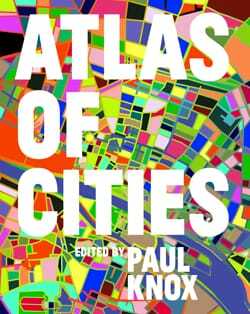Atlas of Cities
Paul Knox (editor)
Princeton University Press
1 William Street, Princeton, NJ 08540; press.princeton.edu.
2014. 256 pages. Hardback, $49.50.
Most atlases are largely collections of maps. A compelling and unique book, Atlas of Cities goes beyond maps to provide insights into the dynamics of how cities shape contemporary social and economic activities. Framed around 13 urban geographic types, this book not only broadens readers’ knowledge about today’s urbanism but also questions the future of life in an increasingly urban world. Accounts of exciting development strategies and technological applications are balanced by sobering discussions of worsening problems of inequality, migrant anomie, and worsening climate change.
Each city prototype is explored in a chapter containing one or more “core” city examples chosen by the authors to illustrate the key features of the type. Arranged in chronological order, the chapters start with the familiar historic stories: the “foundational” cities of Athens and Rome, the “networked” merchant cities of late medieval Europe, the “imperial” city of Istanbul, the “industrial” city of Manchester, and the “rational” city of Paris in the 20th and 21st centuries. For those interested in modern urbanism, the chapters proceed to the “global” city exemplified by London and New York, the “celebrity” city of Los Angeles, the “megacity” of Mumbai (formerly Bombay), the “instant” city of Brasilia, the “transnational” city of Miami, the “creative” city of Milan, the “green” city of Freiburg, and the “intelligent” city of London. To understand the book’s approach, the reader should consider three of the 13 prototypes: megacity, creative city, and green city.
“Megacities” are those with more than 10 million inhabitants. Mumbai is selected as the core exemplar. As of 2013, the world contained 28 megacities: Tokyo-Yokohama was the largest, with 37,239,000 people; New York came in eighth, with 20,673,000; and Mumbai was 13th, with 17,307,000. Most megacities are in the developing world, fueled by rural-to-urban migration and coping with strained infrastructure and problematic densities. Mumbai is nearly 18 times as crowded as New York, even though they have comparable populations. Mumbai continues to grow outward, making it difficult to commute. Its rail system carries 7.2 million passengers per day. And nearly half the people in Mumbai, a city of extremes, live in slums, despite a large and prosperous middle class.
“Creative” cities contain a rich mix of creative industries that share ideas and resources and generate a distinctive local vibe. Milan is the selected core city. The commingling of the creative class—a term coined by Richard Florida, who wrote the book’s foreword—brings together the social worlds of work and lifestyle. Creative cities like Milan, with its Italian design aesthetic in industrial design, furniture, and fashion, become global tastemakers. Along with the hubs of its larger city-region, Milan has transformed itself into an ecology of design, architecture, manufacturing, and craftsmanship. As the book notes, “. . . urban governance . . . has become increasingly concerned with providing a ‘good business climate’ that might attract investment. The increasing entrepreneurism of urban governance has made rebuilding, repackaging, and rebranding the urban landscape a common priority among large cities.” Like many places, Milan enlisted “starchitects” such as Daniel Libeskind and Zaha Hadid to build its symbolic capital, created design districts to house its creative enterprises, and marketed itself through a conscious city-branding campaign.
“Green” cities are focused on sustainability, where “politicians, urban planners, and citizens are working toward developing more resilient infrastructures, institutions, and behaviors to help them face the problem of climate change.” Freiburg, Germany, the selected core city, has set the goal of becoming one of the most sustainable places in the world by reducing carbon emissions by 40 percent by the year 2030. Freiburg, the smallest core city with a population of 220,000, has already made significant progress. It reduced its carbon emissions by 14 percent as of 2007, implementing two completely green neighborhoods and shifting to renewable energy sources. Other small cities have joined together in international networks, such as the Slow City movement whose charter emphasizes a calmer and less polluted environment.
The book is written by an accomplished slate of geographers and urban studies experts. The editor, Paul Knox, is a distinguished professor of urban affairs at Virginia Polytechnic Institute and State University. His fellow authors include 16 academics whose research centers on one or more of the cities discussed. The result is an original synthesis of the operations of the urban world, packaged in a glossy, large-format book in which colorful infographic images of maps, tables, and diagrams share every page with text. This is a book for the eye as well as the brain.
Atlas of Cities has some shortcomings, however. It neglects the history and importance of East Asian cities, tends to oversimplify some complex issues in order to reduce them to dramatic graphics, and identifies significant urban problems, such as rampant migration, but suggests few long-range solutions. However, until a comparable atlas with a broader world focus and a longer-range outlook appears, this is one of the most thought-provoking and accessible books available on contemporary urbanism.





